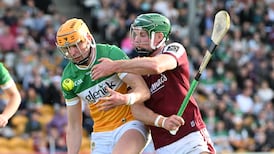GAA president Aogán Ó Fearghail was the first to articulate in public the odd coincidence that marked this year's All-Ireland club finals.
Speaking earlier this month at the launch of the GAA’s plans to commemorate Easter 1916, he pointed out that all four clubs contesting last week’s All-Irelands were named after historical figures and that two of them specifically referenced 1916.
As things turned out the latter two, Limerick’s Na Piarsaigh and Dublin champions Ballyboden St Enda’s, won respectively the hurling and football titles and both for the first time.
The clubs were both founded around the time of the 50th anniversary of the Rising. Na Piarsaigh was established in Limerick in 1968 and named after Patrick Pearse, who appears on the club crest, whereas Ballyboden St Enda's is a 1969 amalgamation of Ballyboden Wanderers, founded in 1910, and Rathfarnham St Enda's, named after Pearse's school.
The 1916 commemorations reach their high point this weekend – somewhat strangely and as a result of the decision to mark the centenary at Easter rather than on the exact dates.
A flavour
GAA director general Páraic Duffy noticed in the coincidence of dates that the last Sunday in April, the day of the Divisions One and Two league finals, would be the precise centenary of Easter Monday 1916, the day the Rising began, and it was decided that the Croke Park commemoration would take place on that day.
The question of what is being commemorated naturally arises. Ruán Magan, who will direct the event in April, gave a flavour of what was in store.
“The GAA is more than just an athletic organisation. It’s a movement. Maybe as a movement it’s the clearest manifestation of the ideals of the (1916) proclamation: liberty, equality and fraternity – this notion of all Ireland being part of this new Ireland. That emerged out of the 1916 Rising,” he said in his introductory remarks before adding later.
“It will be very much about celebrating the Irish flag, celebrating GAA history and everything that it means but being focused on and conscious of the inclusivity of the flag: Catholic, Protestant – all of us together as one.”
It is clear from this and other comments by the GAA president that this event would not be based on a triumphal, nationalist interpretation of the Rising as the first shots (literally) in the War of Independence but on the ideals of the proclamation and the aspirational symbolism of the Irish flag, as referred to by Ó Fearghail.
“The whole significance of the flag – of the green and the orange and especially the white, the peace, the goodness and the future – is an important message we would like to get across.”
There isn't however a lot that can be done about one of the tricolour's central realities: the continuing failure of Irish nationalism to reach lasting accommodation with Northern unionism and vice versa, which has rendered the flag a mostly green emblem.
Despite its hopeful origins and well- meaning advocates, the flag is still one of the troublesome emblems of life in Northern Ireland.
Former Armagh captain Jarlath Burns raised hackles last year when saying that he believed the flag was an issue in the North and that he didn't feel it was central to GAA identity.
“Yeah, it wouldn’t cost me a thought and you know this; flags are divisive. Do we need to say that any louder? If somebody was to propose in the morning that they were going to get rid of them all, it wouldn’t bother me at all. It’s not one of the core values that I have.”
Then there is another troublesome reality that has only in recent times been brought out of the shadows. The GAA at the time of the Rising was a broad church in which a number of important officials were members of the IRB and supportive of revolution but the membership at large reflected the country at the time.
It didn’t support revolution and when the Irish Volunteers split, the majority followed John Redmond’s urging and headed for the Western Front.
Aogán Ó Fearghail made this very point in a recent interview with this newspaper. “There’s no doubt we were a broad church. I started a process in Ulster that is ongoing and I hope will be finished in the next year and a half to look at World War One. There were far more GAA members in the general sense involved in that than in the War of Independence or 1916. There’s no doubt about that.”
Ordinary membership
Speaking to Seán O’Rourke on RTÉ radio, the president however added that the GAA had no plans to reflect this aspect of history in April’s commemorative event.
“We don’t, no. We’re very direct in saying that. We reflect all of that in many different events but the 24th April is very much focused on the events of Easter Week and we’re unapologetic in that. It was a seminal moment in Irish history. The GAA was very much part of all that and we will remember those events.”
The GAA was indeed part of the Rising and many important personalities from the world of Gaelic games had prominent roles in that and what followed – but amongst the ordinary membership there were a lot more who went to France.
It would greatly enhance the inclusive intentions of the upcoming commemorative event were that significant detail to be recognised. smoran@irishtimes.com










